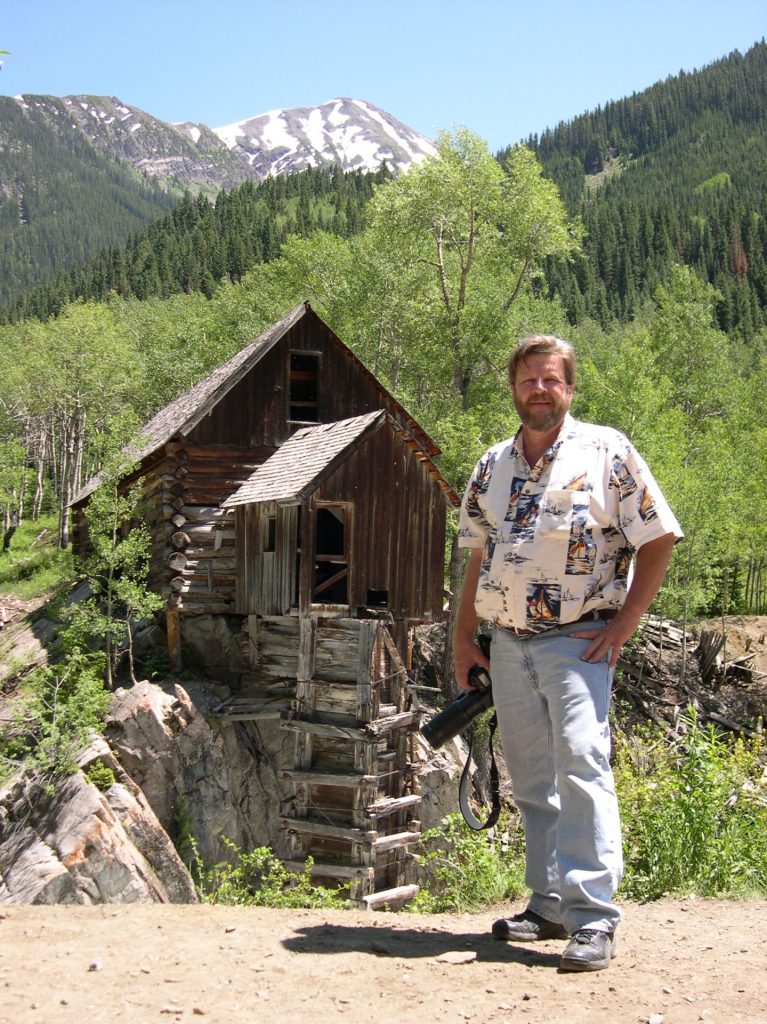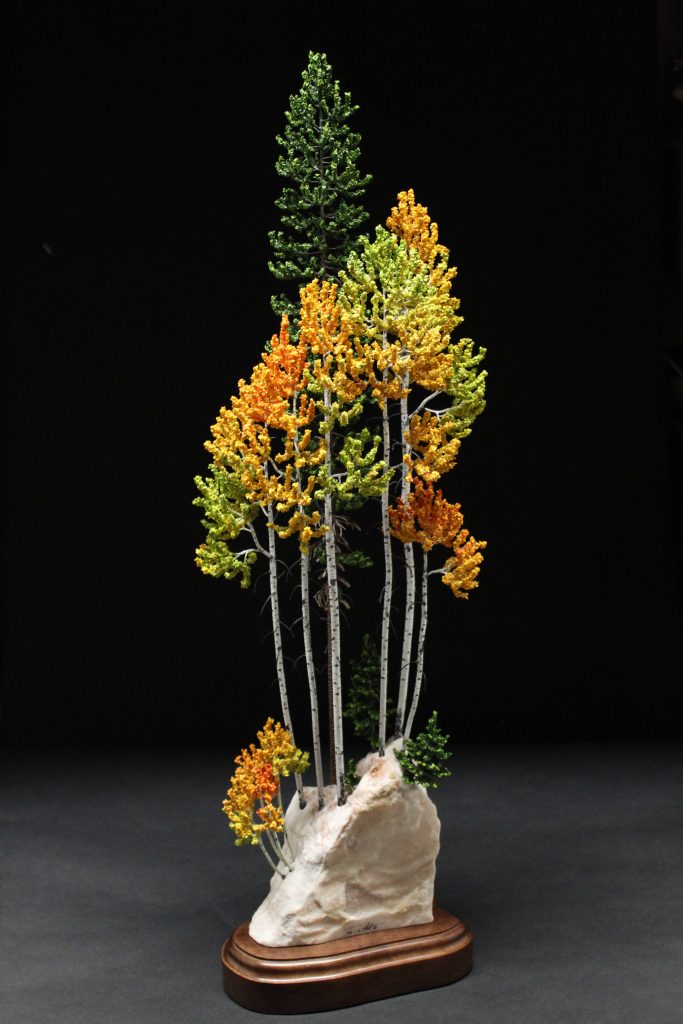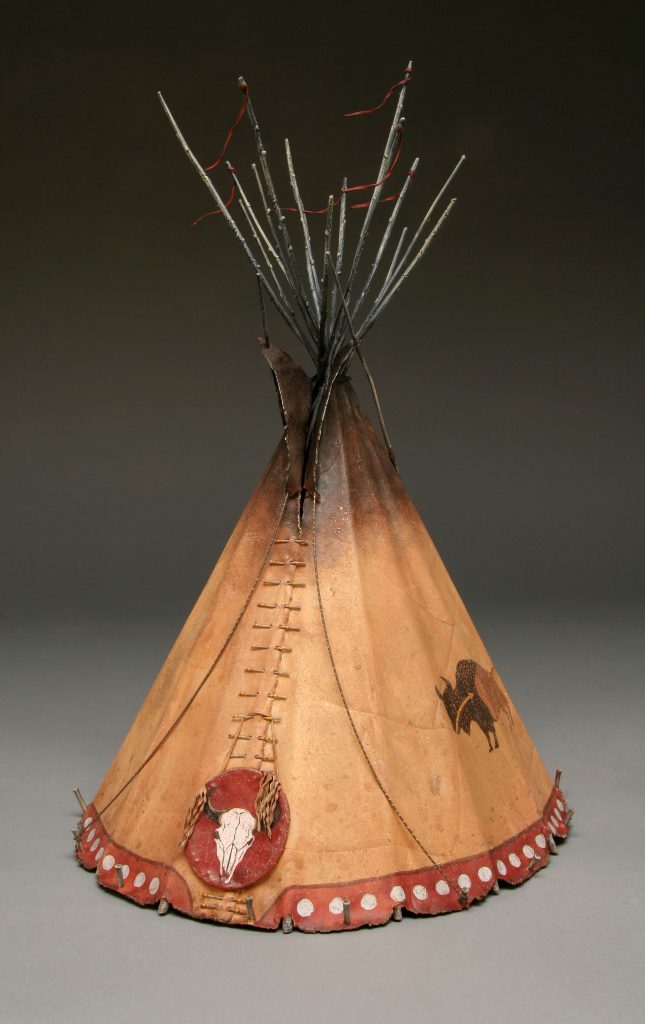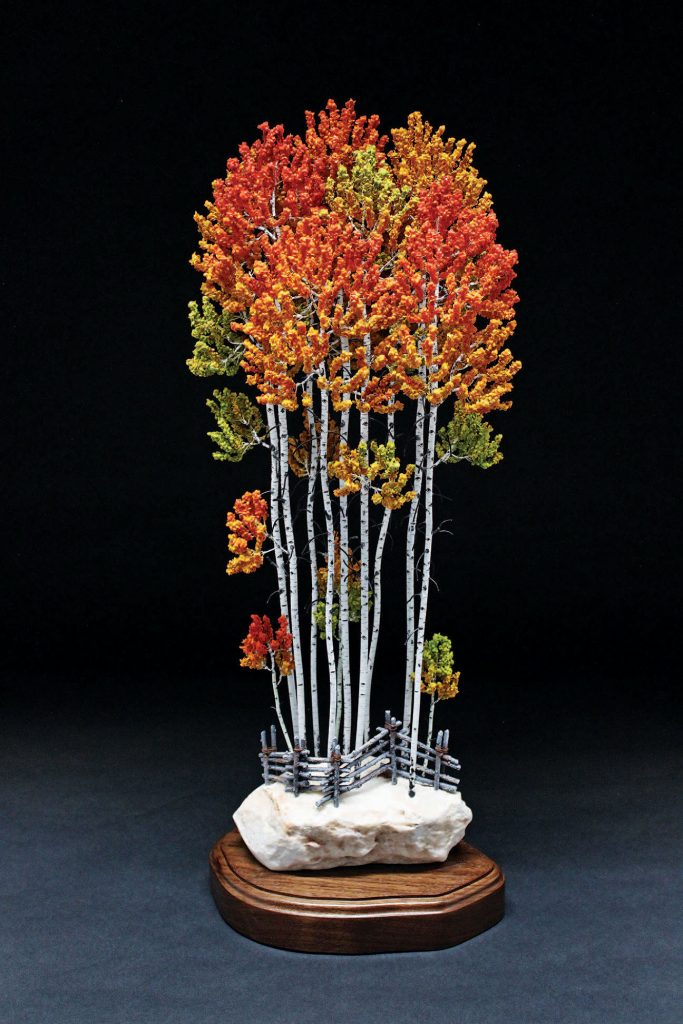His sculptures of aspens and Ponderosa pines are compelling to look at and complex to make.
We featured Don DeMott and his aspen tree sculptures in our October 2021 issue. The conversation ranged from his early days working in the family business to his discovery of Colorado — through the songs of John Denver — to his artistic life now, working on sculptures out of his studio in Loveland.
His meticulous process is fascinating — so much so that we decided to go into detail here.
Cowboys & Indians: Your Western-setting sculptures of aspen trees are strikingly beautiful and phenomenally detailed. What is your process for making them?
Don DeMott: I start with alabaster stone that is mined in Colorado, by the Wyoming border, digging through piles of stone which are remnants or the crusted edges of huge boulders that have been sawed and air-chiseled down to a smaller, more manageable size. When the stones get back to my studio, they are pressure-washed, rough edges are sanded smooth, and a spot on the stone is picked to be grinded smooth and compound-polished for my eventual signature.
I then sketch a contoured pattern template of the bottom edge of the stone for the custom walnut wood base that will be bolted to the stone. A ball-bearing turntable is installed into the bottom of the walnut base so the collector can rotate the heavy piece for 360-degree viewing with the push of a finger. Then, threaded bolt receivers are threaded into the bottom of the walnut to later receive the bolts to secure the piece into its crate.
Then I pick a title for the preconceived piece and issue a serial number, both of which are lasered into the walnut base — the serial number is on the bottom, and the title and my name are visible on the walnut base edge and filled in with a gold color.
The alabaster stone is the foundation and will set the tone for the piece, the size of the trees, and even the colors of the trees. I set the stone on a turntable and then on my welding table so I can rotate.
Don DeMott at the mine.
C&I: Okay, so you’ve got the foundation of the work with the base that will hold the sculpture. Now what?
DeMott: Now it gets interesting. Each stone from the earth has its own special energy. I tune in to that energy and the terrain by resting both hands on the stone for several minutes to determine what scene will resonate best with that stone. Then I sit back and look at the stone from all angles, and now I can see the piece before I begin. Ya know it’s funny, I have been attracted to resting my hands on the stone for years without really knowing why except that there was some form of communication going on…..when something like that happens, ya don’t ask questions ,ya just do it. It was just recently that I asked an old friend who studies such subjects. This is when I learned that I was receiving energy from the earths stone.
If the stone calls for a log fence, then I start with that first by sculpting the logs then drilling in the post. Then I shield the stone from the 2,000-degree torch flame, and I weld the bottom rails and work my way up. This contours the zigzag log or split-rail fence to the stone’s shape.
Ponderosa Autumn
Now I sculpt the tallest and center point aspen of the piece first (center point aspen means center of the scene and not the center of the stone). Once completed, it is drilled into the alabaster stone.
Then I start the next aspen that will be compatible with the previous tree as if they grew next to each other — and so on until I fill the stone with a grove that looks natural, feels right, while trying to achieve realism as if a chunk of the forest was cut out of a mountain side.
Once the main aspen grove is in, if I need a pine tree, I do that next. Sculpting a medium or large pine can take several hours to a couple of days and may contain hundreds or thousands of individual welds depending on how big the pine is. Sculpting the dead branches on a large Ponderosa and adding bark to them with molten steel is a time-intensive process, as is the bark cutting down the trunk.
Now I move on to smaller aspens or pines, or both, to complete the scene.
Every tree gets a tag welded on it with a number that matches the hole number where it came from. I then color-tag each tree so I know what color leaves to add to the tree when they are all separated from the piece.
C&I: And now you start painting?
DeMott: Each aspen tree gets three coats of paint. Once they’ve dried, I paint the details on the trunks, detailed eyes, chew scars, bark knots, and lines. The Pines also get three coats of paint. Then I paint details into the bark and main and dead branches.
Blackfoot Buffalo
C&I: How do you make the aspen leaves and pine needles?
DeMott: Leaves are made of an organic material. They go through an elaborate coloring process before they are applied to the tree with special adhesives one branch at a time. At the same time, I’m coordinating the colors.
After drying for 24 hours, the leaves are ready for more vivid coloring by adding paint. Then a special seal coat of adhesive is added to seal the leaves to themselves from the outside and to the branches by completely dipping the trees.
They are hung to dry, and the bare main branches and trunks are rinsed to remove any film from the adhesive. This special seal coat is repeated again the next day.
C&I: And now back to the alabaster and walnut base. …
DeMott: The alabaster is cleaned again, signed, and lacquered. Two bolts are drilled into the bottom of the stone and epoxied in with enough bolt protruding out to secure the walnut base to the stone. The bolts have to carefully be placed so as not to interfere with the built-in turntable in the walnut base.
The holes are drilled into the walnut base; then from the bottom the bolt holes are countersunk with larger holes to receive washers and the nuts to secure the walnut to the stone. This process was created so that if a collector scars or scratches the lacquered walnut base, it can be removed and shipped without the piece to be refinished. So far this has not happened — KNOCK ON WOOD!
Now without bolting the wood base on yet, the stone is set into the walnut base. The piece is measured, and I order a custom crate to be built. Then one by one each tree has the numbered tags removed and is placed back into the stone exactly where they came from until the scene is set in place. Each tree is then securely epoxied into the hole one at a time.
The piece is then photographed and videoed on an electric rotating turntable.
A custom drawer is built that slides in and out of the crate, and the piece is bolted to the drawer. Even if the crate is flipped upside down the piece remains securely in place.
Forever Fall
C&I: Tell us about how you make your tepees.
DeMott: The tepees are made from copper and steel. I start with sculpting the poles for the frame and make them look like log poles that taper down. A single pattern of the tepee is cut from a larger sheet of copper. A method is used to rough up the smooth copper; stitching seams are pressed into the copper to represent the 18-some buffalo hides it took to make a large tepee. I then make different doors for each tepee. The doors also go through the process to look like animal hides with fringe that appears to be leather — all made from copper. The bones that stitch up the front seam of the tepee are steel pins that are drilled in and welded. Steel wire is used for ropes to open and close the chimney flaps and ties the poles together at the top.
The bottom of the tepee is steel and arc-welded on. Adjustable feet are arc-welded on so the tepee can be adjusted to sit level and hover just above any surface that it will sit on to avoid scratching that surface. The tepee is then sandblasted so that the paint will stick. Two coats of primer are added to the tepee, and it goes through another process to give the appearance of buffalo hide. The primer is dried and baked on with heat. I then mix several colors of flat enamels to look like leather and apply to the tepee. Once that has dried, I then decide what to decorate the tepee with. It could be otters, crows, buffalos, horses, borders with dots — whatever I choose, I hand-draw and paint the designs on the “skin” of tepee.
C&I: What are some challenges you’ve been facing?
DeMott: Designing and scaling down my work for smaller sculptures is no easy task. Everything from the stone to the walnut base to the trees and the shipping method has to be scaled down and remain in proportion.
And the virus affected me and all my suppliers. Costs continue to go up as do freight rates and other materials, my 17 manufacturers that I depend on for materials are suffering from material shortages and labor shortages.
Find out more at demottaspentrees.com
Photography: (All images) courtesy Don DeMott


















